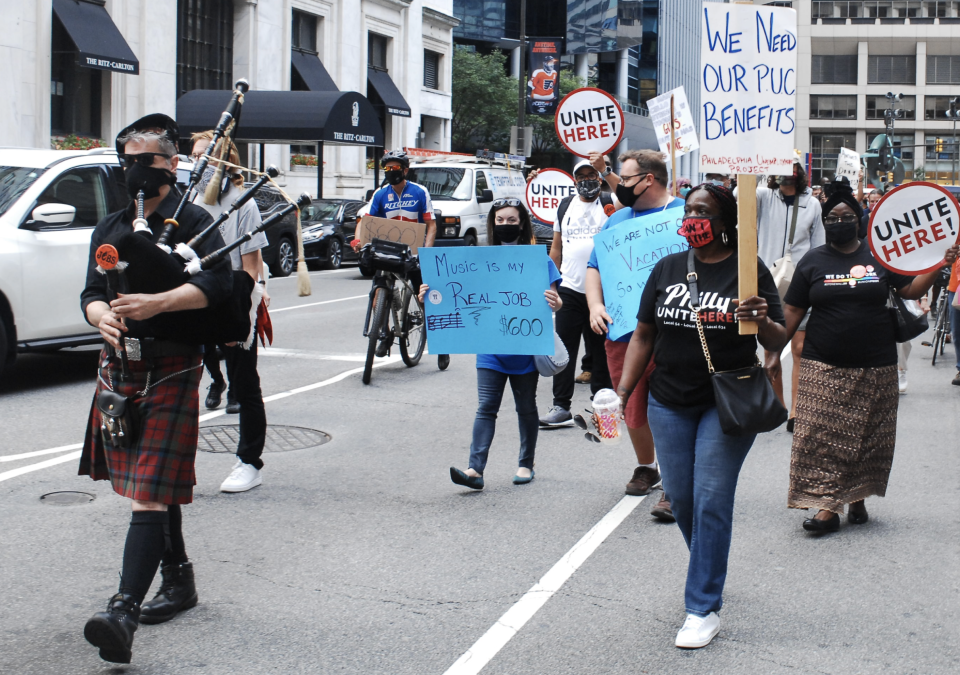Coronavirus stimulus: Extra unemployment benefits still delayed as states struggle with Trump order
Half of U.S. states are in the process of implementing a presidential memo that provides an extra $300-$400 of weekly jobless benefits after $600 of additional weekly unemployment benefits provided by the Coronavirus Aid, Relief, and Economic Security (CARES) Act expired at the end of July.
But only Arizona has actually started distributing the money as states struggle with administering the aid redirected by the executive directive instead of issued by an act of Congress.
“If it was an act of Congress, they could just use their regular system to pay these benefits,“ Michele Evermore, a senior policy analyst at the National Employment Law Project, told Yahoo Money. But with the memorandum, “they have to set up a benefit that's parallel to unemployment insurance.”

About 28 million jobless Americans currently receiving unemployment insurance amid the coronavirus pandemic saw a lapse in the $600 in weekly additional benefits at the end of July amid stalled negotiations over new stimulus legislation between the White House and Congressional Democrats.
Those Americans may have to wait another month or more for any additional benefits.
‘States are really trying to expedite this money’
On August 8, President Trump attempted to address several key issues with an executive order and three memos related to evictions, student loans, extra weekly unemployment benefits, and payroll taxes.
President Trump stated that the unemployment benefits order would provide an “extra $400 per week,” but most states are opting for $300 a week because that option is cheaper and less complex to administer. (Only Kentucky, Montana, and West Virginia have said they will pay the full $400.)
Twenty-five states have either signaled that they are moving forward with the Lost Wages Assistance (LWA) application to unlock the extra $300 in weekly jobless benefits or have already been approved for the money as of Saturday.
“States are really trying to expedite this money,” Evermore said. “Even the states that ordinarily are a little bit poky about getting benefits feel that this is the priority for the administration so ‘We better not embarrass the president right before an election.’”

But despite attempts to speed up the process — and as new jobless claims unexpectedly increased to 1.1 million this week — most states are still unable to distribute the money.
“When we see that states are approved and that funds are flowing to the state,” Evermore noted, “that doesn't necessarily mean they're able to pay out the benefit.”
Maryland, which was approved for extra unemployment benefits under the LWA program on Thursday, aims to start distributing the benefits “by late September.” Colorado, which was approved on Wednesday, expects to start paying out the benefits “mid-to-late September.”
‘Different views of the unemployed in different parts of the country’
The $300 benefits won’t be equally distributed in different states, compared with the CARES Act, where each state added a flat $600 in weekly benefits.
While three states opted for the $400 route, South Dakota declined the extra $300 altogether — meaning jobless South Dakotans will continue receiving only their regular state benefits.
“People have different views of the unemployed in different parts of the country,” Andrew Stettner, an unemployment insurance expert and senior fellow at the Century Foundation, a think tank told Yahoo Money. “You don't have a guarantee of this aid, depending on where you live.”

Fourteen states — Arizona, Colorado, Idaho, Iowa, Kentucky, Louisiana, Maryland, Michigan, Missouri, Montana, New Mexico, North Carolina, Oklahoma, and Utah — have been approved for the benefits.
Another 11 states — Alabama, Alaska, Arkansas, California, Indiana, New York, Texas, Tennessee, Virginia, West Virginia, and Washington— have either signaled they’ll apply or already applied.
Once a state is approved and receives the funding, they have to figure out a way to completely sequester the money they’re paying under the LWA from the money they use for paying regular Unemployment Insurance (UI) benefits.
That involves setting up a parallel system to pay the benefits would likely include hiring a vendor and getting a new computer system up and running.
After the extra unemployment benefits expired and before President Trump’s signed the executive memo, Evermore presciently predicted that a presidential directive instead of Congressional action “would really be a nightmare. It would just end up resulting in people thinking they're getting a benefit but states being unable to figure out how to do it in many cases.”
Denitsa is a writer for Yahoo Finance and Cashay, a new personal finance website. Follow her on Twitter @denitsa_tsekova.
Read more:
Analysis: 1 in 3 jobless Americans could be left out of Trump's action on unemployment
Even as GDP tanked, personal income grew thanks to government support
Read more personal finance information, news, and tips on Cashay
Follow Yahoo Finance on Twitter, Facebook, Instagram, Flipboard, SmartNews, LinkedIn, YouTube, and Reddit.

 money
money 

